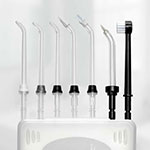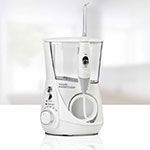
Water Floss vs. String Floss vs. Interdental Brushes
"Floss regularly" is good advice that any dentist will give. But there's more to know about flossing than just the fact that you should do it.
Here we take a look at the three main types of flossing: string flossing, interdental brushing, and water flossing.
String Flossing
String flossing is the most well-known type of flossing: It's the classic version, which involves running a string of floss between the teeth by hand.
This basic type of flossing is great for removing debris from between the teeth. But it does have some drawbacks: It might cut or irritate the gums and it can be difficult for some people to reach all of their teeth.
Interdental Brushing
A regular-sized toothbrush can't reach many areas between the teeth. But an interdental brush can.
Interdental brushes are small brushes specifically meant for cleaning between the teeth. These can be particularly helpful for reaching areas that are tough even for string floss to hit, such as the back teeth. Regardless of the area, many people find interdental brushes easier and more pleasant to use than string floss.
Water Flossing
Water flossers use a jet of water to remove plaque and debris from around and in between teeth.
The WATERPIK water flosser removes up to 99.9% of plaque bacteria from treated areas, and for many users it is the most comfortable method of flossing. Water flossers are also highly versatile: Customizable tips can allow for cleaning around oral inserts such as braces or dental implants, which can be difficult with other types of flossing.
Frequency
Regardless of the tool you use, the most important factor in the success of flossing is how often you do it. It's best to choose the method that's most comfortable and effective for you—in other words, the one you're most likely to stick with. More and more people are finding that water flossing is that method.


